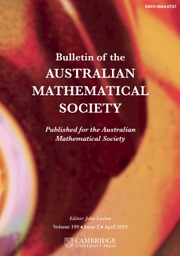No CrossRef data available.
Article contents
DIVISIBILITY AMONG POWER GCD MATRICES AND POWER LCM MATRICES
Published online by Cambridge University Press: 01 September 2025
Abstract
For any integers x and y, let  $(x, y)$ and
$(x, y)$ and  $[x, y]$ stand for the greatest common divisor and the least common multiple of x and y, respectively. Let
$[x, y]$ stand for the greatest common divisor and the least common multiple of x and y, respectively. Let  $a,b$ and n be positive integers, and let
$a,b$ and n be positive integers, and let  $S=\{x_1, \ldots , x_n\}$ be a set of n distinct positive integers. We denote by
$S=\{x_1, \ldots , x_n\}$ be a set of n distinct positive integers. We denote by  $(S^a)$ and
$(S^a)$ and  $[S^a]$ the
$[S^a]$ the  $n\times n$ matrices having the ath power of
$n\times n$ matrices having the ath power of  $(x_i,x_j)$ and
$(x_i,x_j)$ and  $[x_i,x_j]$, respectively, as the
$[x_i,x_j]$, respectively, as the  $(i,j)$-entry. Bourque and Ligh [‘On GCD and LCM matrices’, Linear Algebra Appl. 174 (1992), 65–74] showed that if S is factor closed (that is, S contains all positive divisors of any element of S), then the GCD matrix
$(i,j)$-entry. Bourque and Ligh [‘On GCD and LCM matrices’, Linear Algebra Appl. 174 (1992), 65–74] showed that if S is factor closed (that is, S contains all positive divisors of any element of S), then the GCD matrix  $(S)$ divides the LCM matrix
$(S)$ divides the LCM matrix  $[S]$ (written as
$[S]$ (written as  $(S)\mid [S]$) in the ring
$(S)\mid [S]$) in the ring  $M_n({\mathbb Z})$ of
$M_n({\mathbb Z})$ of  $n\times n$ matrices over the integers. Hong [‘Divisibility properties of power GCD matrices and power LCM matrices’, Linear Algebra Appl. 428 (2008), 1001–1008] proved that
$n\times n$ matrices over the integers. Hong [‘Divisibility properties of power GCD matrices and power LCM matrices’, Linear Algebra Appl. 428 (2008), 1001–1008] proved that  $(S^a)\mid (S^b)$,
$(S^a)\mid (S^b)$,  $(S^a)\mid [S^b]$ and
$(S^a)\mid [S^b]$ and  $[S^a]\mid [S^b]$ in the ring
$[S^a]\mid [S^b]$ in the ring  $M_{n}({\mathbb Z})$ when
$M_{n}({\mathbb Z})$ when  $a\mid b$ and S is a divisor chain (namely, there is a permutation
$a\mid b$ and S is a divisor chain (namely, there is a permutation  $\sigma $ of order n such that
$\sigma $ of order n such that  $x_{\sigma (1)}\mid \cdots \mid x_{\sigma (n)}$). In this paper, we show that if
$x_{\sigma (1)}\mid \cdots \mid x_{\sigma (n)}$). In this paper, we show that if  $a\mid b$ and S is factor closed, then
$a\mid b$ and S is factor closed, then  $(S^a)\mid (S^b)$,
$(S^a)\mid (S^b)$,  $(S^a)\mid [S^b]$ and
$(S^a)\mid [S^b]$ and  $[S^a]\mid [S^b]$ in the ring
$[S^a]\mid [S^b]$ in the ring  $M_{n}({\mathbb Z})$. The proof is algebraic and p-adic. Our result extends the Bourque–Ligh theorem. Finally, several interesting conjectures are proposed.
$M_{n}({\mathbb Z})$. The proof is algebraic and p-adic. Our result extends the Bourque–Ligh theorem. Finally, several interesting conjectures are proposed.
Information
- Type
- Research Article
- Information
- Copyright
- © The Author(s), 2025. Published by Cambridge University Press on behalf of Australian Mathematical Publishing Association Inc.
Footnotes
The research was partially supported by the National Science Foundation of China, Grant no. 12171332.


